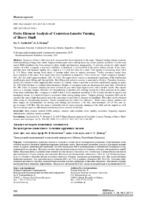Finite Element Method Analysis of Centreless-Lunette Turning of Heavy Shafts

Date
2017Publisher
Another Title
Анализ методом конечных элементов бесцентрово-люнетного точения крупных валов
Bibliographic entry
Vasilevich, Yu. V., Dounar S. S. Finite Element Method Analysis of Centreless-Lunette Turning of Heavy Shafts = Анализ методом конечных элементов бесцентрово-люнетного точения крупных валов / Yu. V. Vasilevich, S. S. Dounar // Наука и техника. – 2017. – № 3. - С. 196-205.
Abstract
Dynamics of heavy lathe tool ta be renovated has been simulated in the paper. Original turning scheme concerns finish-machining of large rotor shafts. High-positioned parts and a milling head may create dynamic problems. For this very reason FEM-simulation has been carried in static, modal and harmonic arrangements. A carrying system for shaft support consists of a bed, a support, a tool and a tailstock. A headstock is not involved in the given turning scheme. It has emerged that static and dynamic rigidity for a support is 3–4-fold less than for a shaft. Tool rigidity is decreasing from 186.5 to 11.9 N/μm when passing from statics to turning rather close to support resonance. Twelve resonance modes have been evaluated in the paper. Two modes have been considered as dangerous. These modes are “shaft swinging in lunettes” (M1, 26.7 Hz) and “support pecking” (M3, 54.4 Hz). The paper shows excessive mechanical compliance of the bed that has insufficiently rigid ribbing and through holes. Bed filling with polymer concrete is moderately effective. Transition from two-lunette (2L) scheme of shaft support to three-lunette (3L) scheme makes it possible to increase significantly rigidity in statics (by 2.09-fold) but there is a limited effect dynamics. Heights of resonance peaks are decreasing not more than 1.32-fold for M1, M3. Effect of dynamic damping has been revealed in case when high support closes with a middle lunette. The support serves as a dynamic damper. Measures for strengthening of machine tool carrying system have been analyzed in the paper. It has been established that swinging of a shaft which is to be machined according to M1 is badly blocked by passive and mechanical means. It is better to bypass a resonance while setting cutting modes. “Support pecking” resonance (M3) can be raised in the zone of high frequencies and at the same time it is possible to decrease its amplitude. This effect can be obtained while using all strengthening measures. Partial strengthening has rather low efficiency. While using a heavy machine tool three ranges are recommended for milling and turning: pre-resonance (<20 Hz), inter-resonance (35–45 Hz) and super-resonance (>65 Hz). The last range is preferable due to super-resonance damping of the shaft and the support as well. The next design step is to add triangle connecting rods or caissons for the bed.
Abstract in another language
Смоделирована динамика тяжелого токарного станка после планируемой реновации. Оригинальная схема точения касается чистовой обработки крупных роторных валов. Высокорасположенные детали и фрезерная головка могут создавать динамические проблемы. Поэтому проведено МКЭ-моделирование в статической, модальной и гармонической постановках. Несущая система для удержания вала состояла из станины, суппорта, инструмента и задней бабки. Передняя бабка в данной схеме точения не участвовала. Оказалось, что статическая и динамическая жесткость для суппорта в 3–4 раза меньше, чем для вала. Жесткость на инструменте снижается с 186,5 до 11,9 Н/мкм при переходе от статики к точению вблизи резонанса суппорта. Оценено двенадцать резонансных мод. Две моды признаны наиболее опасными. Это «раскачка вала в люнетах» (M1, 26,7 Гц) и «клевки суппорта» (M3, 54,4 Гц). Показана избыточная податливость станины, имеющей недостаточно жесткое оребрение и сквозные отверстия. Заполнение станины полимербетоном умеренно эффективное. Переход от двухлюнетной (2L) схемы поддержки вала к трехлюнетной (3L) дает хороший рост жесткости в статике (в 2,09 раза), но ограниченный эффект в динамике. Высоты резонансных пиков снижаются не более чем в 1,32 раза для M1 и M3. Обнаружен эффект динамического гашения при сближении высокого суппорта со средним люнетом. Суппорт выступает динамическим демпфером. Проанализированы меры усиления несущей системы станка. Установлено, что раскачка обрабатываемого вала по M1 плохо блокируется пассивно-конструктивными средствами. Резонанс лучше обходить при назначении режимов резания. Резонанс M3 «клевки суппорта» можно поднять в область высоких частот и одновременно снизить его амплитуду. Это достигается применением сразу всех мер усиления. Частичное усиление малоэффективно. Для фрезерования и точения на тяжелом станке рекомендованы три диапазона: дорезонансный (<20 Гц), межрезонансный (35–45 Гц) и зарезонансный (>65 Гц). Последний диапазон предпочтителен из-за зарезонансного демпфирования как вала, так и суппорта. Следующим конструктивным шагом должно стать добавление в станину треугольных связей или кессонов.
View/
Collections
- №3[11]
